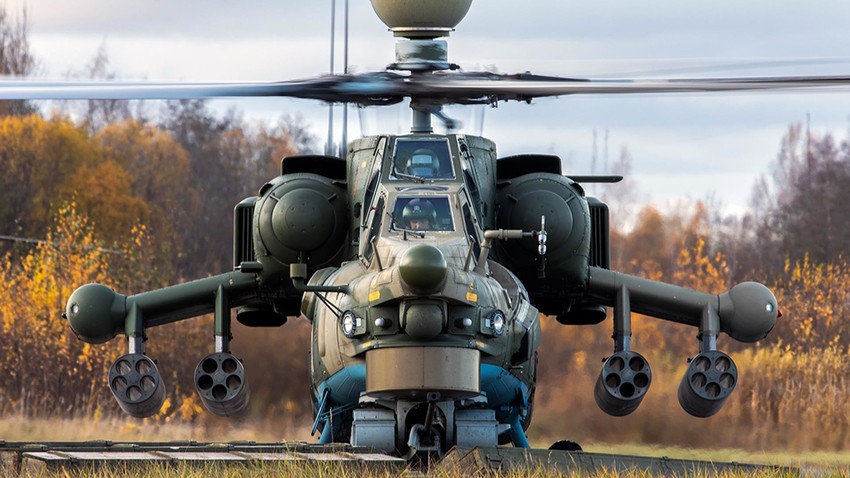Russian Army Aviation is reportedly developing a new method for helicopter pilots to effectively combat attacking kamikaze drones. The development of these countermeasures is rooted in the insights gained from the ongoing conflict in Ukraine.
According to sources cited by Izvestia, the primary strategy for combating these unmanned aerial vehicles (UAVs) involves a combination of evasive maneuvers and speed advantages. Pilots will need to execute precise maneuvers to avoid drone attacks.
However, Russian experts highlight that onboard electronic warfare (EW) systems are crucial to neutralizing these threats.
These systems are designed to disrupt drone operations by blinding their cameras or interfering with their communication channels, thereby mitigating the risk of successful attacks.
Since last year, the Russian Aerospace Forces have introduced new “drone hunter” units, deploying Mi-28 attack helicopters in several regions. These units are specially trained to intercept UAVs and operate day and night, regardless of weather conditions.

In parallel, the Russian Navy has formed special helicopter detachments tasked with searching for and destroying semi-submersible marine drones. Helicopters such as the Ka-27, Ka-29, and Mi-8 are utilized for these missions.
This year, a new section on the destruction of unmanned vehicles has been incorporated into the combat training program for naval aviation helicopters.
The tactics involve the coordinated efforts of pairs of Ka-27 and Ka-29 helicopters, where the former conducts reconnaissance and the latter destroys detected objects.
Furthermore, the combat training program has been tailored to address the specific challenges faced by different fleets of the Russian Navy.
For instance, the Northern Fleet’s anti-drone program focuses on locating complex objects on ice and during the polar night. In contrast, the Pacific Fleet’s program focuses on searching for surface drones across vast areas in adverse weather conditions.
Russian Experts Highlight Importance Of EW
Igor Malikov, an esteemed Test Pilot, underscored the crucial role of electronic warfare equipment in countering drone threats. Malikov explained that detecting small UAVs is difficult due to their size. However, if a drone is visually identified, immediate evasive maneuvers are necessary.
Malikov said that while drones lack the speed to chase down helicopters, they can still mount frontal attacks that cause damage. Hence, equipping helicopters with electronic warfare systems is vital.
These systems are compact and energy-efficient. They can disrupt or confuse approaching drones, enhancing the helicopter’s defense capabilities.
Malikov added that small UAVs often evade radar detection, making visual identification critical. Upon sighting a drone, pilots must swiftly maneuver to avoid collisions, especially since a UAV striking the propeller could force an emergency landing.
Such a scenario is perilous over enemy territory, emphasizing the need for a well-developed drone countermeasure strategy for helicopters, including advanced electronic warfare systems.
Another Russian Military expert, Alexei Leonkov, stated that FPV drones, though slower than helicopters, become a threat when the rotorcraft is hovering or flying at low altitudes.
He noted that maintaining high speed is crucial to avoid these drones, which may attempt collision courses. Recent footage has shown helicopters evading drone attacks due to their speed.
Leonkov also suggested that an effective defense could include electronic warfare systems and smoke screen devices. Additionally, laser beams might disrupt the optics of kamikaze drones by overloading their camera matrices.
Leonkov pointed out that Russian helicopter pilots are already equipped with the L-370 Vitebsk complex, which targets infrared and radar-guided missile systems.
This complex, potentially fine-tuned, could address the drone threat. Onboard defense systems designed for high-speed targets like MANPADS missiles might need to incorporate short-distance laser beams to overwhelm FPV drone sensors.
The need for a comprehensive solution is clear. Leonkov emphasized the importance of targeting the optoelectronic equipment of FPV drones while also leveraging electronic warfare complexes.
These drones maintain a connection with their operators via radio frequencies, making them susceptible to communication disruptions. He further noted that current advancements in electronic warfare against drones should be consolidated to enhance effectiveness.
In summary, the development of methodologies to combat kamikaze drones is imperative for the safety of Russian aviation helicopters. The integration of evasive maneuvers, electronic warfare systems, and potentially laser-based defenses forms a multi-faceted approach to neutralizing drone threats.
The experiences from the ongoing conflict in Ukraine highlight the urgent need for these advancements, ensuring that helicopters and their crews are protected during missions.
- Contact the author at ashishmichel(at)gmail.com
- Follow EurAsian Times on Google News